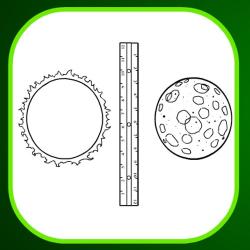Source Institutions
Source Institutions
Add to list Go to activity
Activity link broken? See if it's at the internet archive

Learners investigate why the Sun and Moon appear the same size in the sky even though the Sun is over 400 times larger in diameter. Learners use discs of different sizes and view them from at least 10 feet away. They learn that the larger disc needs to be further away to appear the same size. After completing the activity for a variety of disc sizes, learners can try to predict the position of different discs. When learners set up a free account at Kinetic City, they can answer bonus questions at the end of the activity as a quick assessment. As a larger assessment, learners can complete the Smart Attack game after they've completed several activities.
- Under 5 minutes
- 10 to 30 minutes
- 1 cent - $1 per group of students
- Ages 8 - 11
- Activity, Experiment/Lab Activity
- English
Quick Guide
Materials List (per group of students)
- At least 2 flat discs of 2 different sizes. (For example, you might use a paper plate and a large pizza pan. You can also make your own discs from construction paper or poster board)
- ruler
- tape measure
- Masking tape
- marker
Subjects
-
Earth and Space Science
- Astronomy
- Earth Structure
- Earth, Moon and Sun
-
Solar System
- The Sun
- The Moon
-
Mathematics
-
Measurement
- Units of Measurement
- Circles
-
Measurement
Audience
To use this activity, learners need to:
- see
- read
- use mouse
- be mobile
- touch
Learning styles supported:
- Involves hands-on or lab activities
Other
Components that are part of this resource:
Includes assesments for student learning:
This resource is part of:
Access Rights:
- Free access
By:
- American Association for the Advancement of Science
Rights:
- All rights reserved, American Association for the Advancement of Science, 2009
Funding Source:
- National Science Foundation
